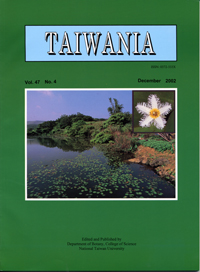Research Paper
Composition, Endemism and Phytogeographical Affinities of the Taiwan Flora
Chang-Fu Hsieh
Published on: December 2002
Page: 298 - 310
DOI: 10.6165/tai.2002.47(4).298
Abstract
The Taiwan vascular flora is exceptionally interesting not only because it is rich and diversified, but because it is of great phytogeographic significance owing to its geographic location. The flora of Taiwan, including naturalized plants, comprises 233 families and 1389 genera with 4216 species. In terms of major growth forms, there are 588 trees, 426 shrubs, 249 lianas, 177 vines, and 2776 herbs or ferns. Approximately 234 species are exotics typically associated with pastures, road clearings and other human disturbances. An extremely large percentage of these naturalized plants are of tropical New World origin. Among the native flora, the Orchidaceae (331 species), Gramineae (249), Compositae (194), Leguminosae (176), Cyperaceae (174), Rosaceae (105), Rubiaceae (93) and Euphorbiaceae (76) rank highest in numbers of species. Clearly, the greatest part of Taiwan's floristics richness comes from a wealth of species in primarily lowland (0–600 m asl.) taxa. A total of 2571 species were recorded in the lowlands, whereas only about 251 species occur between 3100-3950 m. Endemic genera are extremely scarce in Taiwan, with only four, namely Sinopanax (Araliaceae), Hayatella (Rubiaceae), Kudoacanthus (Acanthaceae), and Haraella (Orchidaceae). In contrast to the low percentage of generic endemism, there is a remarkably higher specific endemism. About 1041 species (26.1% of indigenous plants) are known only from Taiwan. A detailed examination of these species shows that there is a distinct trend of increasing endemism with increasing altitude (r² = 0.99). A survey of indigenous non-endemic species on the basis of their geographical distribution outside Taiwan shows that they can be classified into 6 major categories: 1. pantropical and palaeotropical species (1029 species); 2. species distributed in eastern Asia, from Himalayas through southern & eastern China to Taiwan, with some extending to the Ryukyus and Japan (1075 species); 3. widespread species extending from tropical Asia to eastern Asia (232 species); 4. species distributed in Japan and the Ryukyus (189 species); 5. species distributed in temperate and subboreal regions (221 species); and 6. cosmopolitan species (72 species). The main theme of western affinity of Taiwan flora is clearly indicated by almost 52% of the total flora (2069 species) which are also represented in China. The alliances of the flora are also pronounced with the Ryukyus and southern Japan (1618 species in common). However, the close relationship between Taiwan and Japan is through their mutual relation to the lowland flora of southern and eastern China. The tropical elements, mostly ranging from Malaysia to the Philippines, are well represented in the lowlands of Taiwan and particularly in the southernmost Hengchun Peninsula and the Lanyu Island off the southeast coast of Taiwan.
中文摘要
台灣維管束植物不僅豐富多樣,在植物地理上亦深具意義。依據第二版台灣植物誌,台灣自生維管束植物計4216種群、1389屬、233科,其中歸化種計234種群。自生種中各類別之種群數計有蕨類植物595、裸子植物28、雙子葉植物2356、單子葉植物1003。以生活型而言,其中喬木包含588、灌木426、木質藤本249、草質藤本177、草本2776種群。物種數最多之科別為蘭科(331)、禾本科(249)、菊科(194)、豆科(176)、及莎草科(174)。物種數最多之屬依序為薹屬(61)、懸鉤子屬(39)、榕屬(37)、蓼屬(36種)、及鐵角蕨屬(35)。特有屬僅有四屬,但特有種有1041種,特有率達26.1%。經仔細核對,特有種之比率由低海拔地區之16%隨海拔之升高而遞增,到海拔2500公尺以上之山區其特有率可達60%。核對台灣自生種(特有種除外)在台灣以外地區(包括日本、琉球、中國、菲律賓等地)的分佈,加以歸納可區分出六種地理分佈型加上若干亞型。就植物區系而言,東亞物種(占28%)、熱帶物種(27.2%、)及特有物種(26%)旗鼓相當。與鄰近地區之關係,以中國華南及華中最為密切,共通種計2069種,占台灣全部種數的52%;與琉球及日本的共通種居次,計1677種,占42%。
Keyword: Altitudinal distribution, Diversity, Floristic regions, Growth forms, Naturalized plants, Vascular plants.


